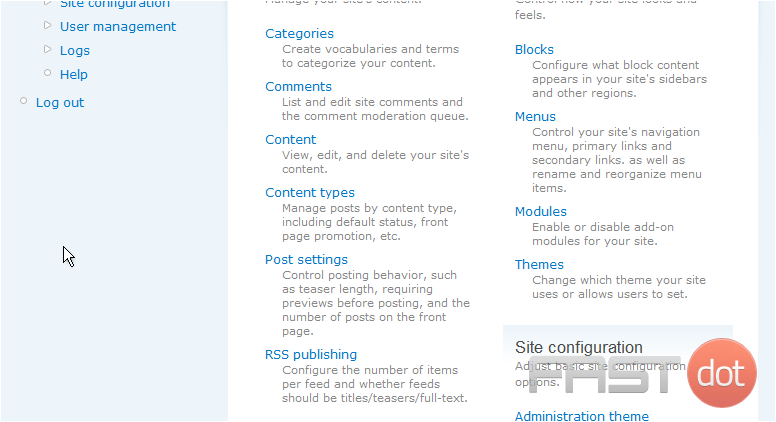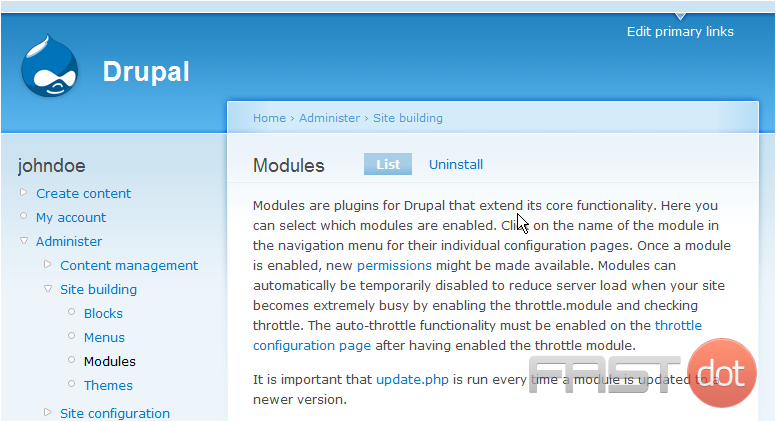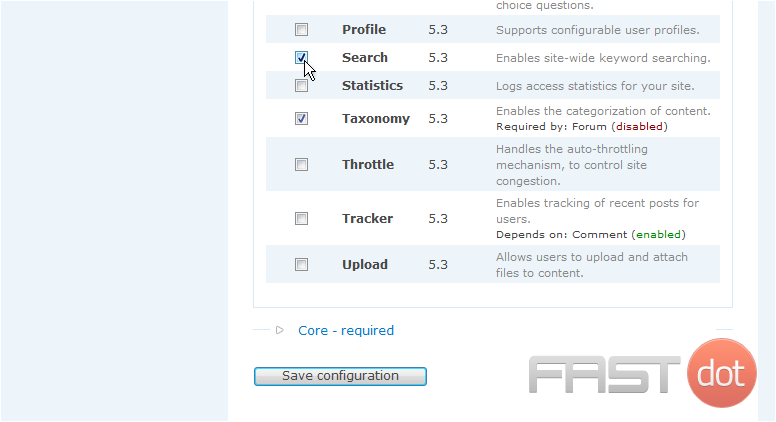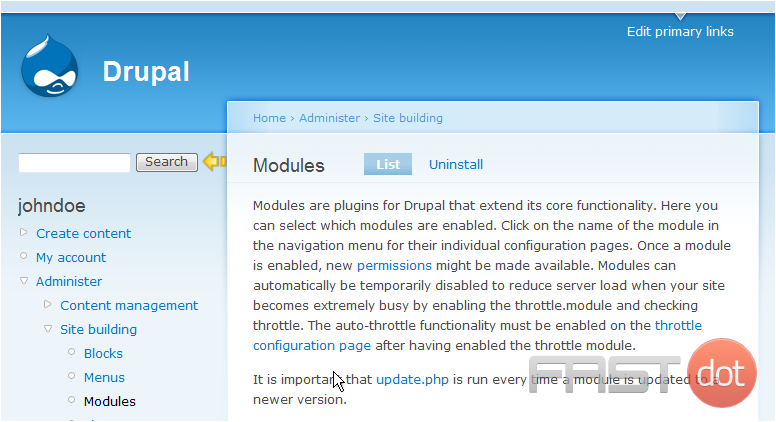This tutorial assumes you’ve already logged in to Drupal
1) Click the Administer link

Now let’s learn how to manage modules
Modules are plugins that extend Drupal’s core functionality. You can add modules for blogs, search, comments, contact forms, forums, and more
2) Then click the Modules link here

This is the Modules main page

3) Let’s use the Search module… select it here

4) Then click Save configuration
That’s it! The Search module has has been activated, as we can see here

We can return to this page at any time to activate, deactivate, or uninstall modules
This is the end of the tutorial. You now know how to manage modules in Drupal
How to Manage Modules in Drupal
Managing modules in Drupal involves installing, enabling, disabling, and configuring various modules to extend the functionality of your site. Follow the steps below to effectively manage modules in Drupal.
Steps to Manage Modules in Drupal
Step 1: Log in to Your Drupal Admin Panel
- Access the Drupal site: Open your browser and go to the Drupal site where you want to manage modules.
- Log in: Click on the Log in link usually located at the top right corner of the page. Enter your username and password, then click Log in.
-
BEST Webhosting
Explore a comprehensive array of web hosting services designed to cater to various needs. Whether you’re an individual looking for reliable personal hosting or a business requiring high-performance solutions, BEST Webhosting offers tailored options to ensure optimal website performance, robust security, and 24/7 support.
-
Unveiling the Pillars of Web Hosting
Web hosting is the backbone of a digital presence, providing the infrastructure necessary to publish and maintain websites online. This article delves deep into the essentials of web hosting, guiding individuals and businesses to make informed decisions. Learn about hosting types, server performance, and scalability options to choose the perfect fit for your online goals.
-
Digital Experience and Coding a New Website
Building a website today involves more than creating an online presence; it’s about delivering an exceptional digital experience. This piece explores modern website design principles, user experience strategies, and advanced coding techniques. It highlights how a well-crafted website can effectively convey your brand message, captivate audiences, and drive business success.
-
How to Buy a .com.au Domain: A Buyer’s Guide to .com.au Domains
This guide is a must-read for startups and established businesses aiming to enhance their Australian online presence. Learn the steps to secure a .com.au domain that aligns perfectly with your brand identity. The article provides insights into domain registration requirements, tips for choosing a memorable domain name, and the benefits of a local domain for SEO.
- Incredible Ideas deserve Incredible DomainsWith Rapid Registration, your domain is registered almost instantly, meaning you don’t have to wait to get your business or name online!
-
Edge of Technology, Digital Transformation, and Cloud Computing
Staying competitive in today’s fast-paced digital landscape requires leveraging cutting-edge technologies. This article explores the vital roles of Digital Transformation (DT) and Cloud Computing in modern business strategies. Understand how these technologies drive efficiency, foster innovation, and enable organisations to scale operations seamlessly.
-
The Best WordPress Plugins for Email Marketing to Grow and Engage Your Subscriber List
Email marketing remains a powerful tool for audience engagement and lead conversion. Discover top WordPress plugins like Mailchimp, Constant Contact, OptinMonster, and Thrive Leads. This article provides detailed guidance on creating effective opt-in forms, segmenting email lists, automating campaigns, and tracking metrics for successful email marketing strategies.
-
The Best WordPress Caching Plugins to Optimize Site Speed and Performance
Website speed and performance are crucial for user experience and SEO rankings. This detailed review covers the most effective WordPress caching plugins, including W3 Total Cache, WP Super Cache, WP Rocket, WP Fastest Cache, and LiteSpeed Cache. Learn how these plugins enhance site performance by minimising load times and optimising server resources.
Step 2: Navigate to the Extend Page
After logging in, navigate to the Extend page:
- Click on Manage in the top menu.
- In the submenu, click on Extend.
Step 3: Install a New Module
To install a new module, follow these steps:
- On the Extend page, click on the Install new module button.
- Enter the URL of the module archive file (usually a .tar.gz or .zip file) or upload it from your computer.
- Click on Install to upload and install the module.
Step 4: Enable a Module
- On the Extend page, find the module you want to enable in the list of available modules.
- Check the box next to the module’s name.
- Scroll down and click on the Install button to enable the module.
Step 5: Disable a Module
- On the Extend page, find the module you want to disable in the list of enabled modules.
- Uncheck the box next to the module’s name.
- Scroll down and click on the Uninstall button to disable the module. Note that some modules may require additional steps for complete uninstallation.
Step 6: Configure a Module
Many modules offer configuration options that allow you to customize their functionality:
- After enabling a module, go to the Configuration page by clicking on Manage > Configuration.
- Find the section related to the module you want to configure.
- Click on the appropriate link to access the module’s settings and make any necessary changes.
- Click on Save configuration to apply your changes.
Additional Tips
- Update Modules Regularly: Keep your modules up to date to benefit from new features and security patches. Check the Drupal website for updates and follow the same process to upload and install the new version.
- Backup Your Site: Before installing or updating modules, always make a backup of your Drupal site, including the database and files.
- Check Compatibility: Ensure that the modules you install are compatible with your version of Drupal. Compatibility information is usually available on the module’s page.
- Read Module Documentation: Always read the documentation provided by the module developers to understand how to use and configure the module correctly.
Conclusion
By following these steps, you can effectively manage modules in Drupal, allowing you to extend the functionality of your site to meet your specific needs. Regularly reviewing and updating your modules will help maintain the security and performance of your Drupal site.


